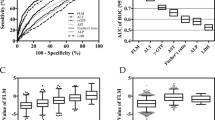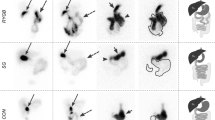Abstract
Commercial assays for serum bile acids (SBA) have made this measurement practical. The purpose of this study was to examine the utility of SBA measured every 30 min after a standardized meal in controls and in patients with acute viral hepatitis, cholestasis, and anicteric cirrhosis. In five controls, repeated examination of the area under the bile acid curve (AUC) was not statistically different, whereas the fasting and 2-hr postprandial levels were significantly different. In the group of patients with anicteric cirrhosis, AUC identified disease in 18/20 using total serum bile acids (TSBAs) and in 15/20 using cholylglycine (CG). AUC can be calculated from three samples obtained at 0, 60, and 120 min without losing the sensitivity achieved with seven serial samples. SGOT, alkaline phosphatase, and serum albumin were compared for sensitivity to the total SBA response curve in 20 patients with anicteric cirrhosis. SGOT and alkaline phosphatase identified only 50% and 55% as abnormal and serum albumin was less sensitive. Using total SBA, combining the fasting level and AUC identified 100% as abnormal; using CG, 85% of these patients were detected. As a stepwise cost-effective approach, the fasting level of SBAs can identify most patients with anicteric liver disease. In cases with normal fasting levels where liver disease is suspected, the three-point AUC determination may identify additional patients.
Similar content being viewed by others
References
Carey JB: The serum trihydroxy-dihydroxy bile acid ratio in liver and biliary tract disease. J Clin Invest 37:1494–1503, 1958
Osborn EC, Wooten ID, Silva LC da, Sherlock S: Serum bile acid levels in liver disease. Lancet 2:1049–1052, 1959
Makino O, Nakagawa S, Shinozaki K, Mashimo K: Sulfated and nonsulfated bile acid in human serum. Lipids 7:750–752, 1972
Neale G, Lewis B, Weaver V: Serum bile acids in liver disease. Gut 12:145–152, 1971
Siskos PA, Cahill PT, Javitt NB: Serum bile acid analysis: A rapid direct enzymatic method using dual-beam spectrofluorometry. Journal Lipid Research 18:666–671, 1977
Kobayashi K, Allen RM, Bloomer JR, Klatskin G: Enzymatic fluorometry for estimating serum total bile acid concentration. JAMA 241:2043–2045, 1979
Demers LM, Hepner GW: Levels of immunoreactive glycine-conjugated bile acids in health and hepatobiliary disease. Am J Clin Pathol 66:831–839, 1976
Miller P, Weiss S, Cornell M, Dockery J: Specific125I radioimmunoassay for cholylglycine, a bile acid in serum. Clin Chem 27:1698–1703, 1981
Kaplowitz N, Kok E, Javitt NB: Postprandial serum bile acid for the detection of hepatobiliary disease. JAMA 225: 292–293, 1973
Korman MD, Hofman AF, Summerskill WHJ: Assessment of activity in chronic liver disease. N Engl J Med 290: 1399–1402, 1974
Dasher CA, Hirschowitz BI, Spenny JG: Radioimmunoassay of serum bile acid levels in biopsy-proven cirrhosis. South Med J 70:968–977, 1977
De Barros SG, Balistreri WF, Soloway RD: Response of total and individual serum bile acids to endogenous and exogenous bile acid input into the enterohepatic circulation. Gastroenterology 82:647–652, 1982
Shull JD Jr, Wilkinson GR, Johnson R: Normal disposition of oxazepam in acute viral hepatitis. Ann Intern Med 84: 420–425, 1976
Uribe M, Schalm SW, Summerskill WHJ, Go VL: Oral prednisone for chronic active liver disease: Dose-response and bioavailability studies. Gut 19:1131–1135, 1978
Colton T: Statistics in Medicine. Boston, Little Brown, 1974
LaRusso NF, Korman MG, Hoffman NE, Hofmann AF: Dynamics of the enterohepatic circulation of bile acids postprandial serum concentration of conjugates of cholic acid in healthy, cholecystectomized patients, and patients with bile acid malabsorption. N Engl J Med 291:689–692, 1974
Hofmann AF: The enterohepatic circulation of bile acids. Clin Gastroenterol 6:3–24, 1977
LaRusso NF, Hoffman NE, Korman MG, Hofmann AF, Cowen AE: Determinants of fasting and postprandial serum bile acid levels in healthy man. Am J Dig Dis 23:385–391, 1978
Shaffer EA, Gordon ER: Serum bile acids as related in bile acid secretion in liver disease. Dig Dis Sci 23:392–397, 1978
Korman MG: Use of serum bile acid levels in the diagnosis of hepatobiliary disease. Intern Med 2:59–68, 1981
Ratnoff OD, Patek AJ Jr: The natural history of Lannec's cirrhosis of the liver. Medicine 21:207, 1942
Author information
Authors and Affiliations
Additional information
Supported in part by a grant from the Diagnostic Division, Abbott Laboratories, North Chicago, Illinois.
Rights and permissions
About this article
Cite this article
Greenfield, S.M., Soloway, R.D., Carithers, R.L. et al. Evaluation of postprandial serum bile acid response as a test of hepatic function. Digest Dis Sci 31, 785–791 (1986). https://doi.org/10.1007/BF01296044
Received:
Revised:
Accepted:
Issue Date:
DOI: https://doi.org/10.1007/BF01296044




